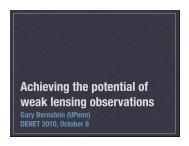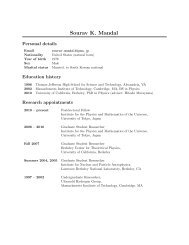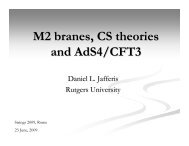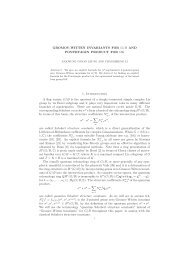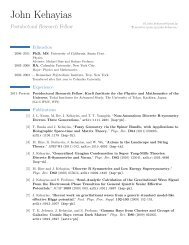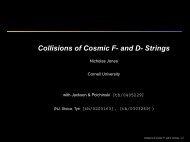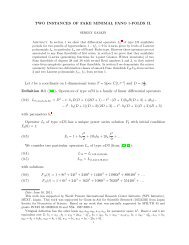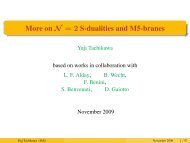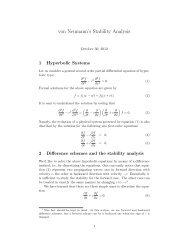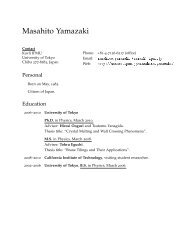STUDY SUMMARY - IPMU
STUDY SUMMARY - IPMU
STUDY SUMMARY - IPMU
Create successful ePaper yourself
Turn your PDF publications into a flip-book with our unique Google optimized e-Paper software.
<strong>SUMMARY</strong> REPORT<br />
WIDE FIELD FIBER-FED OPTICAL<br />
MULTI-OBJECT SPECTROMETER (WFMOS)<br />
location efficiency, evaluating survey completeness, deciding tiling strategy, and prioritizing observations<br />
considering sky brightness and seeing. An observing tool that allocates targets to fibers<br />
will be provided as part of the system software during the construction phase. The additional<br />
steps described here involve interacting with this tool and performing any necessary additional<br />
optimization.<br />
The survey preparations and survey monitoring have many common elements in the two<br />
primary surveys. A number of scientists will participate in the survey phase of WFMOS, and the<br />
primary surveys will be conducted over the course of approximately five years (depending on the<br />
yet-to-be-negotiated agreement with Subaru). The bulk of the day-to-day effort will be conducted<br />
by post-docs under the direction of members of the current science team. The estimated<br />
cost for this phase appears in the Management and Cost volume.<br />
6.3 Installation and Removal<br />
We anticipate that WFMOS observations will be interleaved with observations using other<br />
instruments, including the HyperSuprimeCam. Removing WFMOS from the telescope will necessitate<br />
the removal of the Prime Focus Unit from the telescope, disconnection of the fiber connector,<br />
storage of a portion of the fiber optic cable on the side of the telescope, and possible removal<br />
of the metrology cameras. Removal of WFMOS components from the Prime Focus Unit<br />
will be required to allow the Prime Focus Unit to be reconfigured with HyperSuprimeCam. Installation<br />
of WFMOS is essentially the reverse of this process. We estimate the Prime Focus Unit<br />
can be removed from the Subaru prime focus in less than three hours and be accomplished entirely<br />
with Subaru personnel in a manner similar to standard top-end unit exchanges.<br />
The initial installation of WFMOS components in to the Prime Focus Unit is described in the<br />
Prime Focus Instrument section of the Detailed Technical Design. Routine swaps of HSC and<br />
WFMOS will be a streamlined version of this process. WFMOS is designed to allow the swap of<br />
HSC and WFMOS components within the PFU to take approximately one full work day. This<br />
estimate depends sensitively, however, on the detailed HSC design. Two members of the<br />
WFMOS instrument team will be required to supervise the first two swaps. It is also prudent to<br />
budget an additional few days for the first two swaps. Subsequent swaps would be accomplished<br />
entirely with Subaru Observatory personnel. The detailed procedure and timeline for this process<br />
will be developed before the WFMOS preliminary design review.<br />
6.4 Additional Considerations<br />
In addition to the Dark Energy and Galactic Archaeology survey observations proposed here,<br />
there will be classically allocated non-survey observations. Although not formally requested to<br />
do so by Gemini, we believe it prudent to consider the operational scenarios for these potential<br />
additional observations. We envision that many of these surveys will have long-term status and<br />
be queue scheduled. The rest will be a broad range of observing programs proposed by PIs from<br />
within the Gemini and Subaru communities. These could also be queue scheduled, or the observers<br />
may be given fixed nights and visit the telescope. WFMOS can accommodate these observations<br />
with no additional software cost by using the System Software observing preparation tools<br />
and the Package A data reduction pipeline. The operation of WFMOS will not be very different<br />
from that of other fully automated multi-fiber spectroscopic survey instruments, such as FMOS,<br />
2dF+AAOmega, and FLAMES.<br />
69



